The Impact of Attitudes on Behaviour in Organisational Settings
VerifiedAdded on 2019/11/25
|10
|2379
|179
Essay
AI Summary
This essay delves into the crucial role of employee attitudes in shaping organisational behaviour. It begins by defining attitudes in the workplace and their impact on employee morale, teamwork, and productivity. The essay then explores how attitudes influence behaviour at three levels: personal, group, and organisational, highlighting the importance of positive attitudes for creativity, management, and employee retention. Furthermore, the essay discusses the Theory of Reasoned Action, explaining how attitudes, intentions, and behaviour are interconnected at each level. The study underscores the significance of understanding and managing employee attitudes to foster a productive and positive work environment. The importance of positive attitudes in the workplace and their impact on team work and productivity is also highlighted.
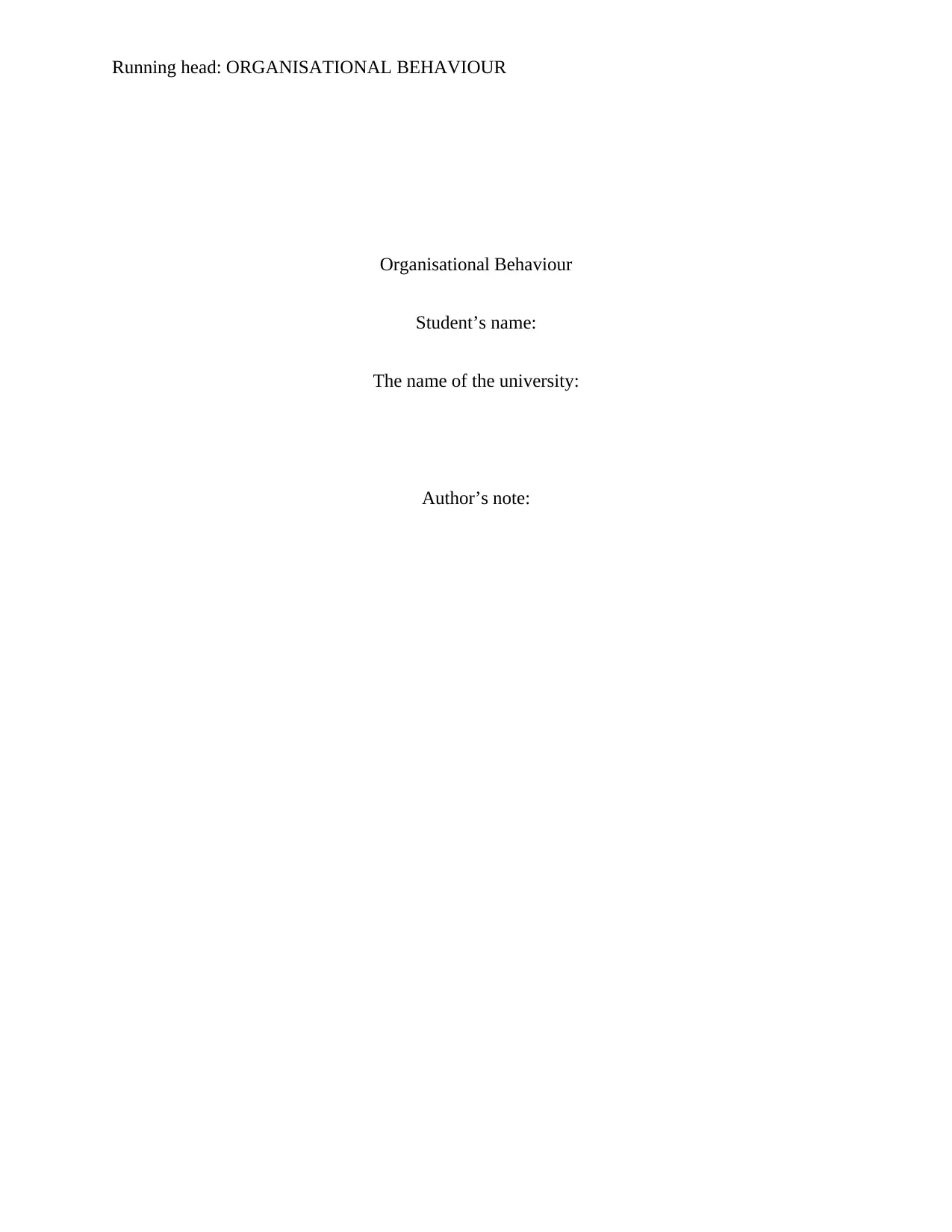
Running head: ORGANISATIONAL BEHAVIOUR
Organisational Behaviour
Student’s name:
The name of the university:
Author’s note:
Organisational Behaviour
Student’s name:
The name of the university:
Author’s note:
Paraphrase This Document
Need a fresh take? Get an instant paraphrase of this document with our AI Paraphraser
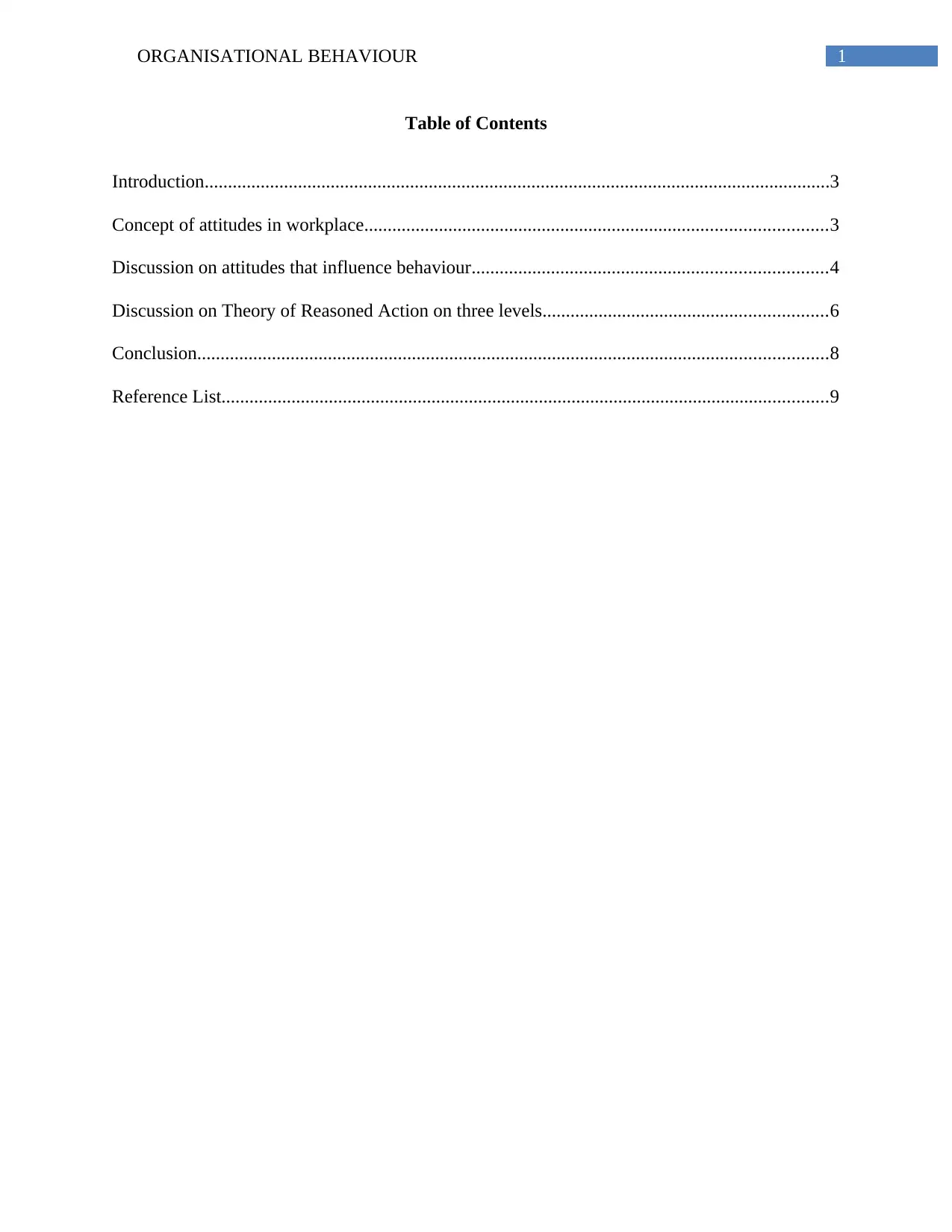
1ORGANISATIONAL BEHAVIOUR
Table of Contents
Introduction......................................................................................................................................3
Concept of attitudes in workplace...................................................................................................3
Discussion on attitudes that influence behaviour............................................................................4
Discussion on Theory of Reasoned Action on three levels.............................................................6
Conclusion.......................................................................................................................................8
Reference List..................................................................................................................................9
Table of Contents
Introduction......................................................................................................................................3
Concept of attitudes in workplace...................................................................................................3
Discussion on attitudes that influence behaviour............................................................................4
Discussion on Theory of Reasoned Action on three levels.............................................................6
Conclusion.......................................................................................................................................8
Reference List..................................................................................................................................9
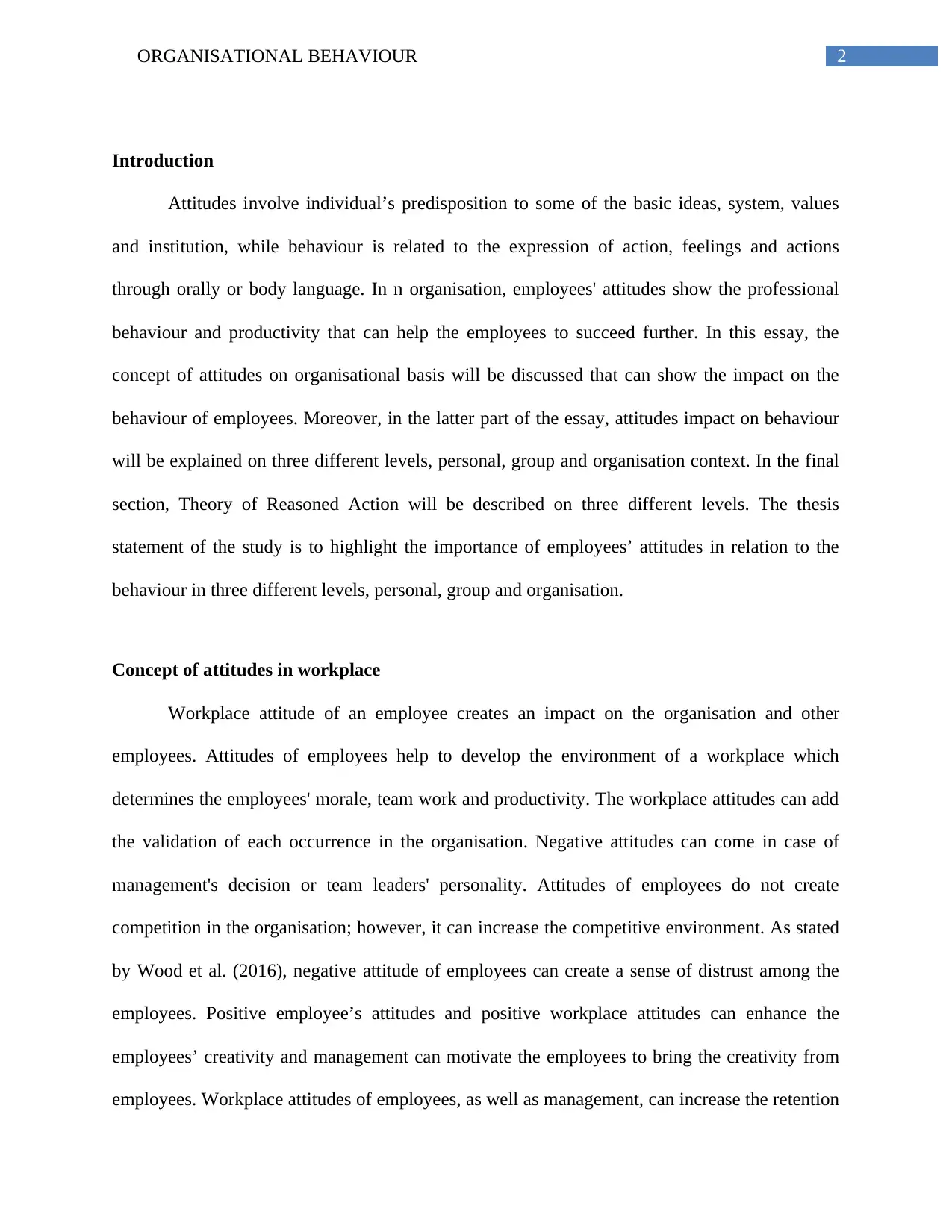
2ORGANISATIONAL BEHAVIOUR
Introduction
Attitudes involve individual’s predisposition to some of the basic ideas, system, values
and institution, while behaviour is related to the expression of action, feelings and actions
through orally or body language. In n organisation, employees' attitudes show the professional
behaviour and productivity that can help the employees to succeed further. In this essay, the
concept of attitudes on organisational basis will be discussed that can show the impact on the
behaviour of employees. Moreover, in the latter part of the essay, attitudes impact on behaviour
will be explained on three different levels, personal, group and organisation context. In the final
section, Theory of Reasoned Action will be described on three different levels. The thesis
statement of the study is to highlight the importance of employees’ attitudes in relation to the
behaviour in three different levels, personal, group and organisation.
Concept of attitudes in workplace
Workplace attitude of an employee creates an impact on the organisation and other
employees. Attitudes of employees help to develop the environment of a workplace which
determines the employees' morale, team work and productivity. The workplace attitudes can add
the validation of each occurrence in the organisation. Negative attitudes can come in case of
management's decision or team leaders' personality. Attitudes of employees do not create
competition in the organisation; however, it can increase the competitive environment. As stated
by Wood et al. (2016), negative attitude of employees can create a sense of distrust among the
employees. Positive employee’s attitudes and positive workplace attitudes can enhance the
employees’ creativity and management can motivate the employees to bring the creativity from
employees. Workplace attitudes of employees, as well as management, can increase the retention
Introduction
Attitudes involve individual’s predisposition to some of the basic ideas, system, values
and institution, while behaviour is related to the expression of action, feelings and actions
through orally or body language. In n organisation, employees' attitudes show the professional
behaviour and productivity that can help the employees to succeed further. In this essay, the
concept of attitudes on organisational basis will be discussed that can show the impact on the
behaviour of employees. Moreover, in the latter part of the essay, attitudes impact on behaviour
will be explained on three different levels, personal, group and organisation context. In the final
section, Theory of Reasoned Action will be described on three different levels. The thesis
statement of the study is to highlight the importance of employees’ attitudes in relation to the
behaviour in three different levels, personal, group and organisation.
Concept of attitudes in workplace
Workplace attitude of an employee creates an impact on the organisation and other
employees. Attitudes of employees help to develop the environment of a workplace which
determines the employees' morale, team work and productivity. The workplace attitudes can add
the validation of each occurrence in the organisation. Negative attitudes can come in case of
management's decision or team leaders' personality. Attitudes of employees do not create
competition in the organisation; however, it can increase the competitive environment. As stated
by Wood et al. (2016), negative attitude of employees can create a sense of distrust among the
employees. Positive employee’s attitudes and positive workplace attitudes can enhance the
employees’ creativity and management can motivate the employees to bring the creativity from
employees. Workplace attitudes of employees, as well as management, can increase the retention
⊘ This is a preview!⊘
Do you want full access?
Subscribe today to unlock all pages.

Trusted by 1+ million students worldwide
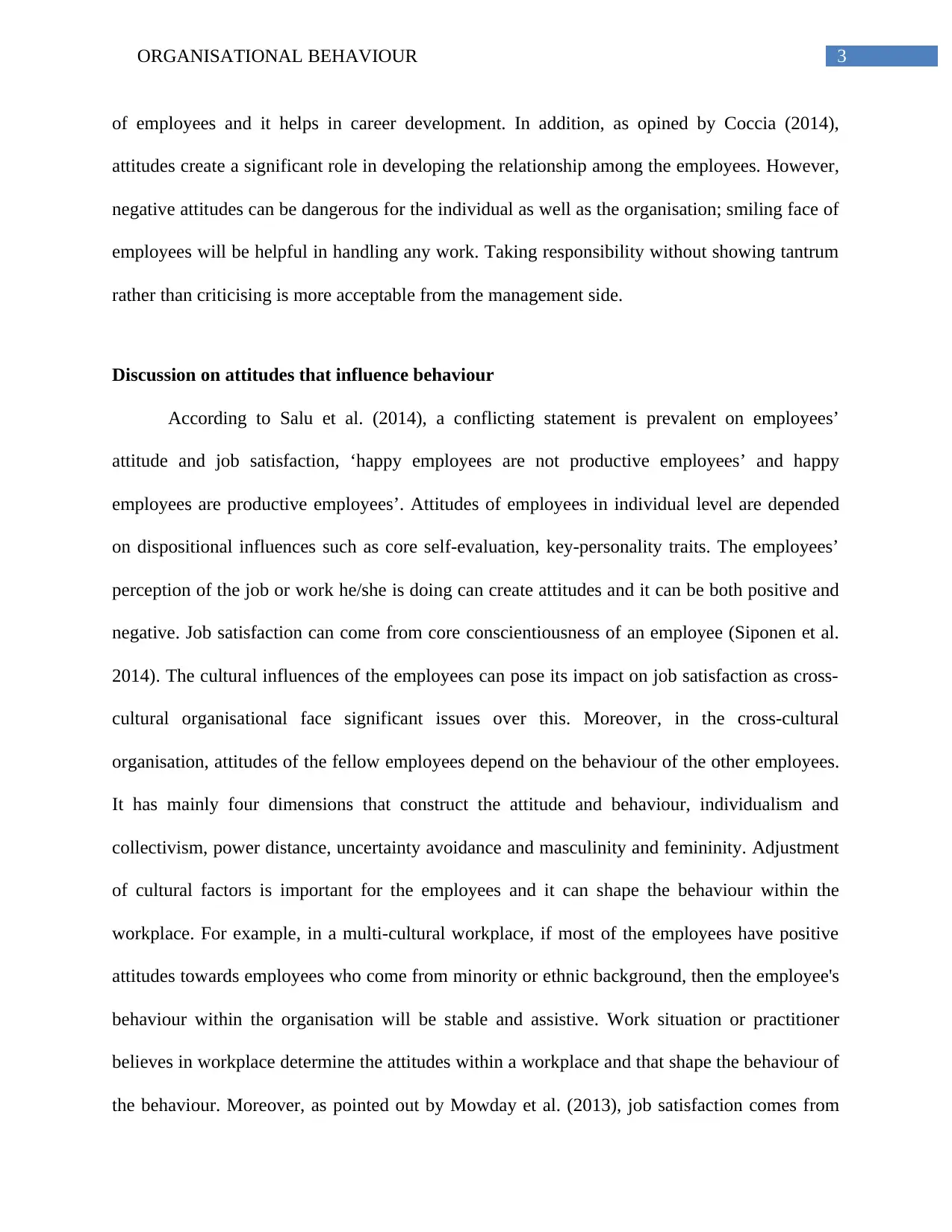
3ORGANISATIONAL BEHAVIOUR
of employees and it helps in career development. In addition, as opined by Coccia (2014),
attitudes create a significant role in developing the relationship among the employees. However,
negative attitudes can be dangerous for the individual as well as the organisation; smiling face of
employees will be helpful in handling any work. Taking responsibility without showing tantrum
rather than criticising is more acceptable from the management side.
Discussion on attitudes that influence behaviour
According to Salu et al. (2014), a conflicting statement is prevalent on employees’
attitude and job satisfaction, ‘happy employees are not productive employees’ and happy
employees are productive employees’. Attitudes of employees in individual level are depended
on dispositional influences such as core self-evaluation, key-personality traits. The employees’
perception of the job or work he/she is doing can create attitudes and it can be both positive and
negative. Job satisfaction can come from core conscientiousness of an employee (Siponen et al.
2014). The cultural influences of the employees can pose its impact on job satisfaction as cross-
cultural organisational face significant issues over this. Moreover, in the cross-cultural
organisation, attitudes of the fellow employees depend on the behaviour of the other employees.
It has mainly four dimensions that construct the attitude and behaviour, individualism and
collectivism, power distance, uncertainty avoidance and masculinity and femininity. Adjustment
of cultural factors is important for the employees and it can shape the behaviour within the
workplace. For example, in a multi-cultural workplace, if most of the employees have positive
attitudes towards employees who come from minority or ethnic background, then the employee's
behaviour within the organisation will be stable and assistive. Work situation or practitioner
believes in workplace determine the attitudes within a workplace and that shape the behaviour of
the behaviour. Moreover, as pointed out by Mowday et al. (2013), job satisfaction comes from
of employees and it helps in career development. In addition, as opined by Coccia (2014),
attitudes create a significant role in developing the relationship among the employees. However,
negative attitudes can be dangerous for the individual as well as the organisation; smiling face of
employees will be helpful in handling any work. Taking responsibility without showing tantrum
rather than criticising is more acceptable from the management side.
Discussion on attitudes that influence behaviour
According to Salu et al. (2014), a conflicting statement is prevalent on employees’
attitude and job satisfaction, ‘happy employees are not productive employees’ and happy
employees are productive employees’. Attitudes of employees in individual level are depended
on dispositional influences such as core self-evaluation, key-personality traits. The employees’
perception of the job or work he/she is doing can create attitudes and it can be both positive and
negative. Job satisfaction can come from core conscientiousness of an employee (Siponen et al.
2014). The cultural influences of the employees can pose its impact on job satisfaction as cross-
cultural organisational face significant issues over this. Moreover, in the cross-cultural
organisation, attitudes of the fellow employees depend on the behaviour of the other employees.
It has mainly four dimensions that construct the attitude and behaviour, individualism and
collectivism, power distance, uncertainty avoidance and masculinity and femininity. Adjustment
of cultural factors is important for the employees and it can shape the behaviour within the
workplace. For example, in a multi-cultural workplace, if most of the employees have positive
attitudes towards employees who come from minority or ethnic background, then the employee's
behaviour within the organisation will be stable and assistive. Work situation or practitioner
believes in workplace determine the attitudes within a workplace and that shape the behaviour of
the behaviour. Moreover, as pointed out by Mowday et al. (2013), job satisfaction comes from
Paraphrase This Document
Need a fresh take? Get an instant paraphrase of this document with our AI Paraphraser
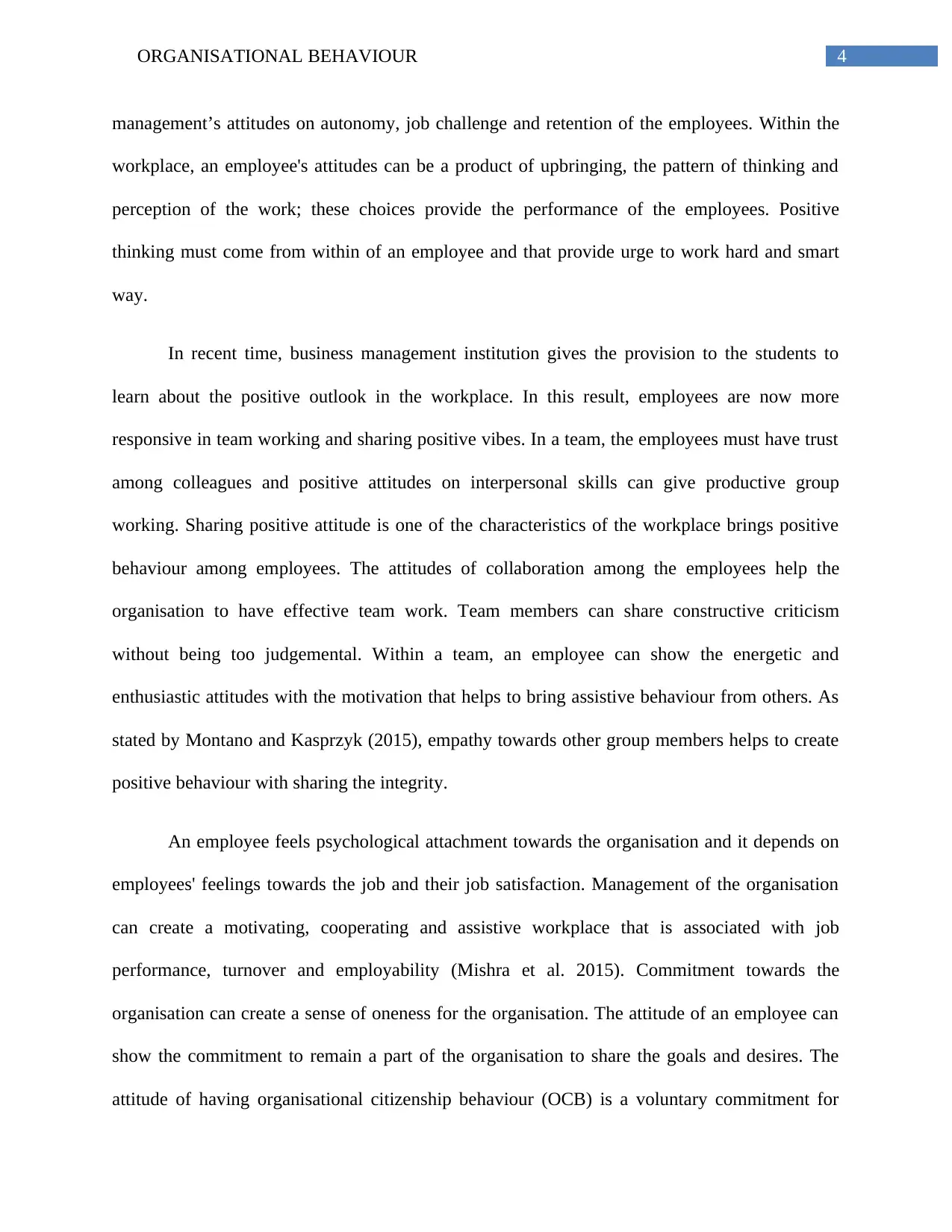
4ORGANISATIONAL BEHAVIOUR
management’s attitudes on autonomy, job challenge and retention of the employees. Within the
workplace, an employee's attitudes can be a product of upbringing, the pattern of thinking and
perception of the work; these choices provide the performance of the employees. Positive
thinking must come from within of an employee and that provide urge to work hard and smart
way.
In recent time, business management institution gives the provision to the students to
learn about the positive outlook in the workplace. In this result, employees are now more
responsive in team working and sharing positive vibes. In a team, the employees must have trust
among colleagues and positive attitudes on interpersonal skills can give productive group
working. Sharing positive attitude is one of the characteristics of the workplace brings positive
behaviour among employees. The attitudes of collaboration among the employees help the
organisation to have effective team work. Team members can share constructive criticism
without being too judgemental. Within a team, an employee can show the energetic and
enthusiastic attitudes with the motivation that helps to bring assistive behaviour from others. As
stated by Montano and Kasprzyk (2015), empathy towards other group members helps to create
positive behaviour with sharing the integrity.
An employee feels psychological attachment towards the organisation and it depends on
employees' feelings towards the job and their job satisfaction. Management of the organisation
can create a motivating, cooperating and assistive workplace that is associated with job
performance, turnover and employability (Mishra et al. 2015). Commitment towards the
organisation can create a sense of oneness for the organisation. The attitude of an employee can
show the commitment to remain a part of the organisation to share the goals and desires. The
attitude of having organisational citizenship behaviour (OCB) is a voluntary commitment for
management’s attitudes on autonomy, job challenge and retention of the employees. Within the
workplace, an employee's attitudes can be a product of upbringing, the pattern of thinking and
perception of the work; these choices provide the performance of the employees. Positive
thinking must come from within of an employee and that provide urge to work hard and smart
way.
In recent time, business management institution gives the provision to the students to
learn about the positive outlook in the workplace. In this result, employees are now more
responsive in team working and sharing positive vibes. In a team, the employees must have trust
among colleagues and positive attitudes on interpersonal skills can give productive group
working. Sharing positive attitude is one of the characteristics of the workplace brings positive
behaviour among employees. The attitudes of collaboration among the employees help the
organisation to have effective team work. Team members can share constructive criticism
without being too judgemental. Within a team, an employee can show the energetic and
enthusiastic attitudes with the motivation that helps to bring assistive behaviour from others. As
stated by Montano and Kasprzyk (2015), empathy towards other group members helps to create
positive behaviour with sharing the integrity.
An employee feels psychological attachment towards the organisation and it depends on
employees' feelings towards the job and their job satisfaction. Management of the organisation
can create a motivating, cooperating and assistive workplace that is associated with job
performance, turnover and employability (Mishra et al. 2015). Commitment towards the
organisation can create a sense of oneness for the organisation. The attitude of an employee can
show the commitment to remain a part of the organisation to share the goals and desires. The
attitude of having organisational citizenship behaviour (OCB) is a voluntary commitment for
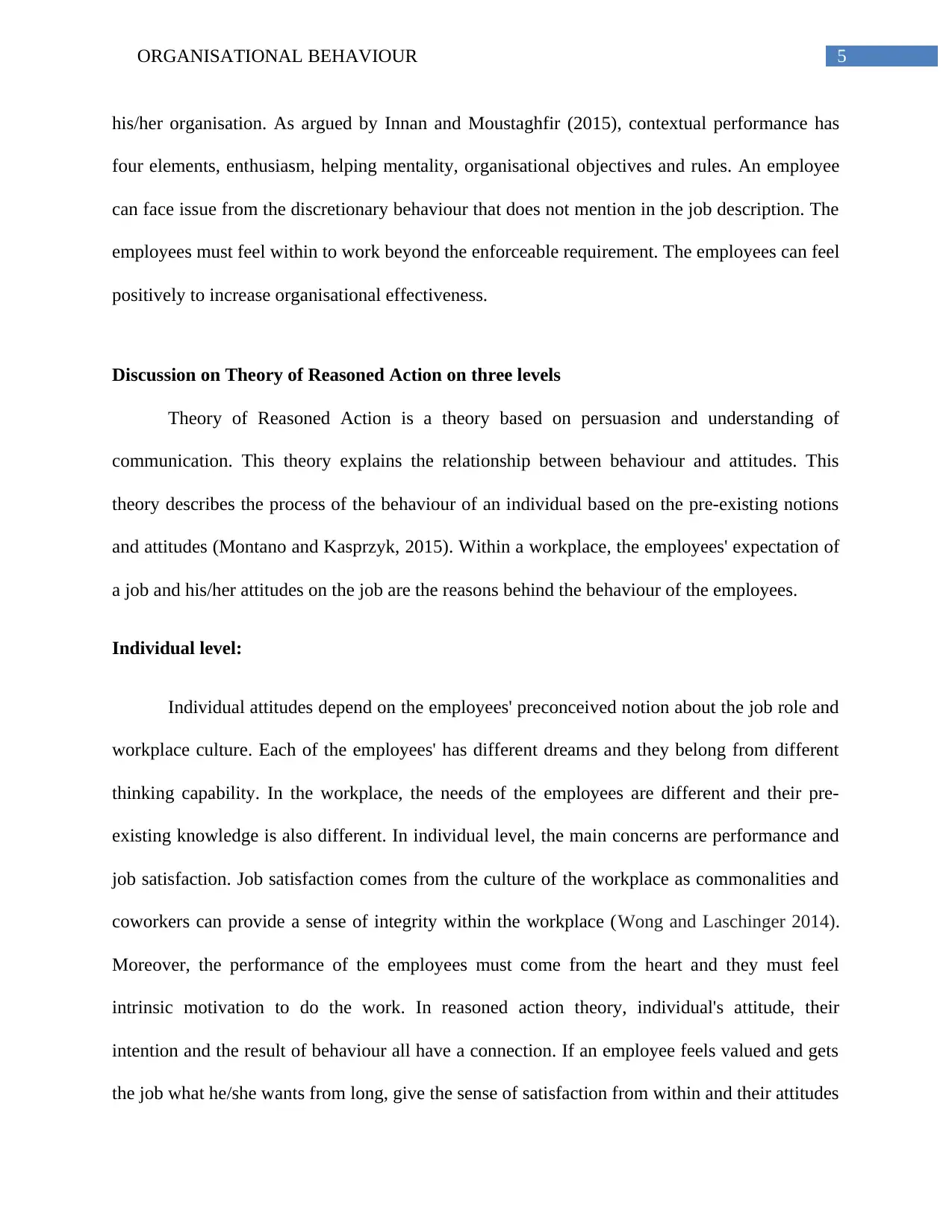
5ORGANISATIONAL BEHAVIOUR
his/her organisation. As argued by Innan and Moustaghfir (2015), contextual performance has
four elements, enthusiasm, helping mentality, organisational objectives and rules. An employee
can face issue from the discretionary behaviour that does not mention in the job description. The
employees must feel within to work beyond the enforceable requirement. The employees can feel
positively to increase organisational effectiveness.
Discussion on Theory of Reasoned Action on three levels
Theory of Reasoned Action is a theory based on persuasion and understanding of
communication. This theory explains the relationship between behaviour and attitudes. This
theory describes the process of the behaviour of an individual based on the pre-existing notions
and attitudes (Montano and Kasprzyk, 2015). Within a workplace, the employees' expectation of
a job and his/her attitudes on the job are the reasons behind the behaviour of the employees.
Individual level:
Individual attitudes depend on the employees' preconceived notion about the job role and
workplace culture. Each of the employees' has different dreams and they belong from different
thinking capability. In the workplace, the needs of the employees are different and their pre-
existing knowledge is also different. In individual level, the main concerns are performance and
job satisfaction. Job satisfaction comes from the culture of the workplace as commonalities and
coworkers can provide a sense of integrity within the workplace (Wong and Laschinger 2014).
Moreover, the performance of the employees must come from the heart and they must feel
intrinsic motivation to do the work. In reasoned action theory, individual's attitude, their
intention and the result of behaviour all have a connection. If an employee feels valued and gets
the job what he/she wants from long, give the sense of satisfaction from within and their attitudes
his/her organisation. As argued by Innan and Moustaghfir (2015), contextual performance has
four elements, enthusiasm, helping mentality, organisational objectives and rules. An employee
can face issue from the discretionary behaviour that does not mention in the job description. The
employees must feel within to work beyond the enforceable requirement. The employees can feel
positively to increase organisational effectiveness.
Discussion on Theory of Reasoned Action on three levels
Theory of Reasoned Action is a theory based on persuasion and understanding of
communication. This theory explains the relationship between behaviour and attitudes. This
theory describes the process of the behaviour of an individual based on the pre-existing notions
and attitudes (Montano and Kasprzyk, 2015). Within a workplace, the employees' expectation of
a job and his/her attitudes on the job are the reasons behind the behaviour of the employees.
Individual level:
Individual attitudes depend on the employees' preconceived notion about the job role and
workplace culture. Each of the employees' has different dreams and they belong from different
thinking capability. In the workplace, the needs of the employees are different and their pre-
existing knowledge is also different. In individual level, the main concerns are performance and
job satisfaction. Job satisfaction comes from the culture of the workplace as commonalities and
coworkers can provide a sense of integrity within the workplace (Wong and Laschinger 2014).
Moreover, the performance of the employees must come from the heart and they must feel
intrinsic motivation to do the work. In reasoned action theory, individual's attitude, their
intention and the result of behaviour all have a connection. If an employee feels valued and gets
the job what he/she wants from long, give the sense of satisfaction from within and their attitudes
⊘ This is a preview!⊘
Do you want full access?
Subscribe today to unlock all pages.

Trusted by 1+ million students worldwide
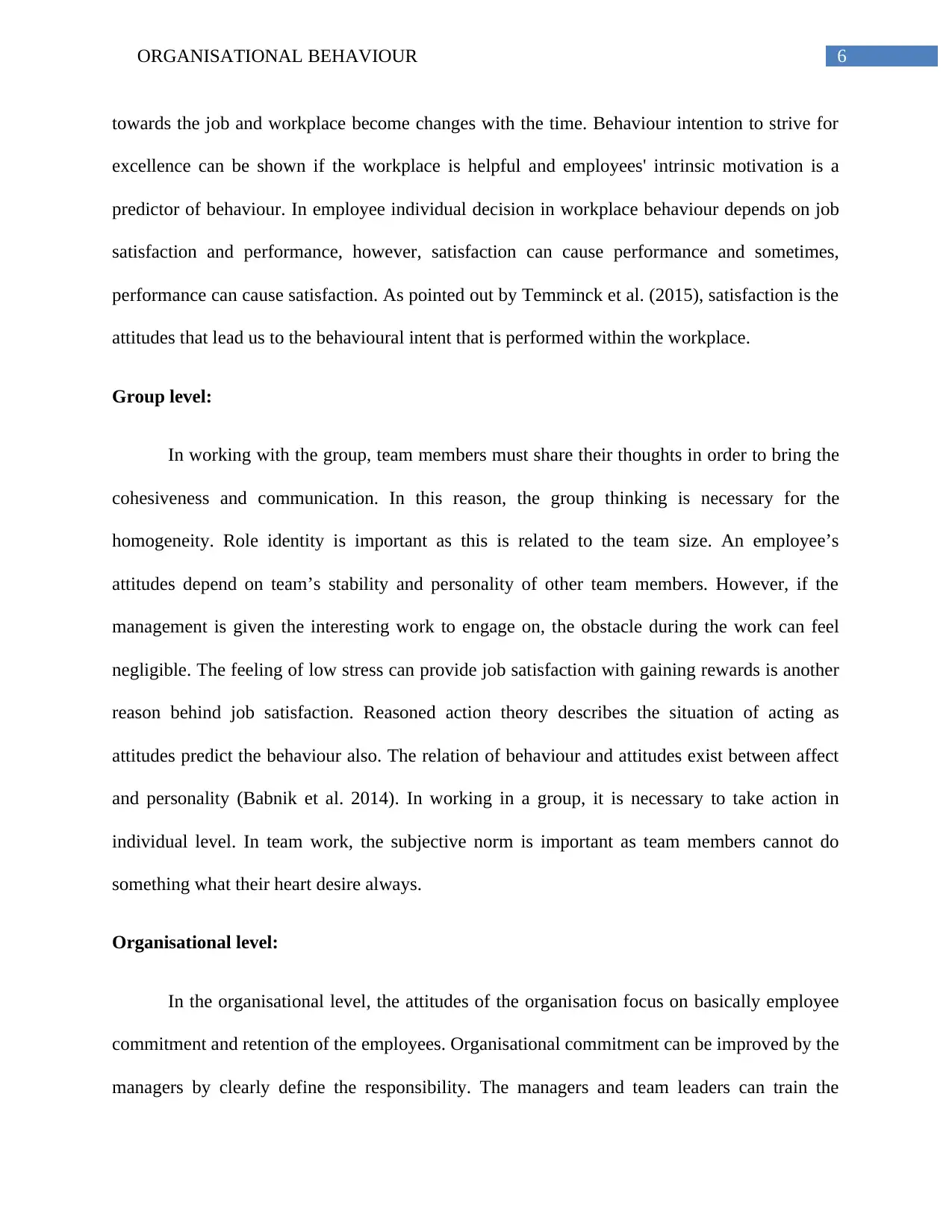
6ORGANISATIONAL BEHAVIOUR
towards the job and workplace become changes with the time. Behaviour intention to strive for
excellence can be shown if the workplace is helpful and employees' intrinsic motivation is a
predictor of behaviour. In employee individual decision in workplace behaviour depends on job
satisfaction and performance, however, satisfaction can cause performance and sometimes,
performance can cause satisfaction. As pointed out by Temminck et al. (2015), satisfaction is the
attitudes that lead us to the behavioural intent that is performed within the workplace.
Group level:
In working with the group, team members must share their thoughts in order to bring the
cohesiveness and communication. In this reason, the group thinking is necessary for the
homogeneity. Role identity is important as this is related to the team size. An employee’s
attitudes depend on team’s stability and personality of other team members. However, if the
management is given the interesting work to engage on, the obstacle during the work can feel
negligible. The feeling of low stress can provide job satisfaction with gaining rewards is another
reason behind job satisfaction. Reasoned action theory describes the situation of acting as
attitudes predict the behaviour also. The relation of behaviour and attitudes exist between affect
and personality (Babnik et al. 2014). In working in a group, it is necessary to take action in
individual level. In team work, the subjective norm is important as team members cannot do
something what their heart desire always.
Organisational level:
In the organisational level, the attitudes of the organisation focus on basically employee
commitment and retention of the employees. Organisational commitment can be improved by the
managers by clearly define the responsibility. The managers and team leaders can train the
towards the job and workplace become changes with the time. Behaviour intention to strive for
excellence can be shown if the workplace is helpful and employees' intrinsic motivation is a
predictor of behaviour. In employee individual decision in workplace behaviour depends on job
satisfaction and performance, however, satisfaction can cause performance and sometimes,
performance can cause satisfaction. As pointed out by Temminck et al. (2015), satisfaction is the
attitudes that lead us to the behavioural intent that is performed within the workplace.
Group level:
In working with the group, team members must share their thoughts in order to bring the
cohesiveness and communication. In this reason, the group thinking is necessary for the
homogeneity. Role identity is important as this is related to the team size. An employee’s
attitudes depend on team’s stability and personality of other team members. However, if the
management is given the interesting work to engage on, the obstacle during the work can feel
negligible. The feeling of low stress can provide job satisfaction with gaining rewards is another
reason behind job satisfaction. Reasoned action theory describes the situation of acting as
attitudes predict the behaviour also. The relation of behaviour and attitudes exist between affect
and personality (Babnik et al. 2014). In working in a group, it is necessary to take action in
individual level. In team work, the subjective norm is important as team members cannot do
something what their heart desire always.
Organisational level:
In the organisational level, the attitudes of the organisation focus on basically employee
commitment and retention of the employees. Organisational commitment can be improved by the
managers by clearly define the responsibility. The managers and team leaders can train the
Paraphrase This Document
Need a fresh take? Get an instant paraphrase of this document with our AI Paraphraser
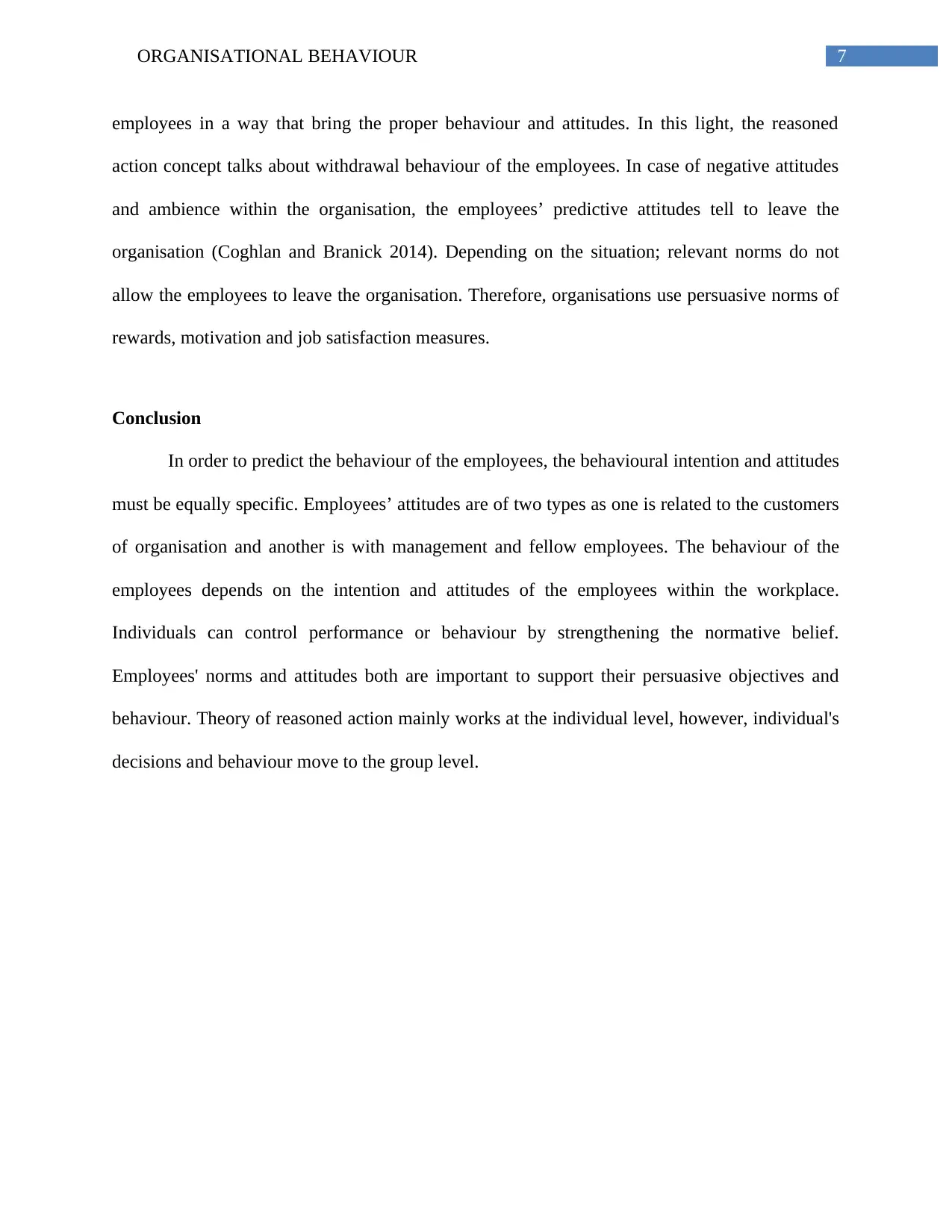
7ORGANISATIONAL BEHAVIOUR
employees in a way that bring the proper behaviour and attitudes. In this light, the reasoned
action concept talks about withdrawal behaviour of the employees. In case of negative attitudes
and ambience within the organisation, the employees’ predictive attitudes tell to leave the
organisation (Coghlan and Branick 2014). Depending on the situation; relevant norms do not
allow the employees to leave the organisation. Therefore, organisations use persuasive norms of
rewards, motivation and job satisfaction measures.
Conclusion
In order to predict the behaviour of the employees, the behavioural intention and attitudes
must be equally specific. Employees’ attitudes are of two types as one is related to the customers
of organisation and another is with management and fellow employees. The behaviour of the
employees depends on the intention and attitudes of the employees within the workplace.
Individuals can control performance or behaviour by strengthening the normative belief.
Employees' norms and attitudes both are important to support their persuasive objectives and
behaviour. Theory of reasoned action mainly works at the individual level, however, individual's
decisions and behaviour move to the group level.
employees in a way that bring the proper behaviour and attitudes. In this light, the reasoned
action concept talks about withdrawal behaviour of the employees. In case of negative attitudes
and ambience within the organisation, the employees’ predictive attitudes tell to leave the
organisation (Coghlan and Branick 2014). Depending on the situation; relevant norms do not
allow the employees to leave the organisation. Therefore, organisations use persuasive norms of
rewards, motivation and job satisfaction measures.
Conclusion
In order to predict the behaviour of the employees, the behavioural intention and attitudes
must be equally specific. Employees’ attitudes are of two types as one is related to the customers
of organisation and another is with management and fellow employees. The behaviour of the
employees depends on the intention and attitudes of the employees within the workplace.
Individuals can control performance or behaviour by strengthening the normative belief.
Employees' norms and attitudes both are important to support their persuasive objectives and
behaviour. Theory of reasoned action mainly works at the individual level, however, individual's
decisions and behaviour move to the group level.
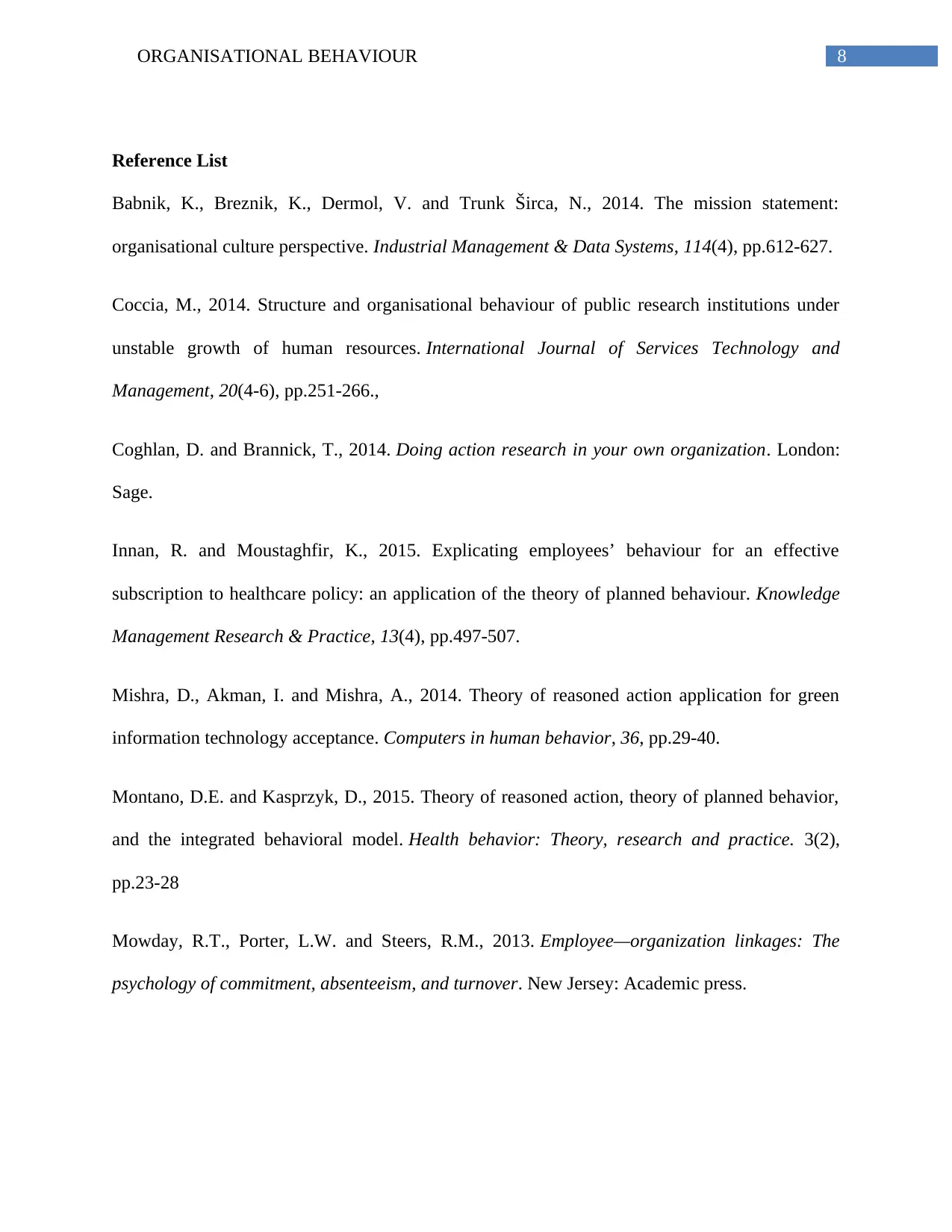
8ORGANISATIONAL BEHAVIOUR
Reference List
Babnik, K., Breznik, K., Dermol, V. and Trunk Širca, N., 2014. The mission statement:
organisational culture perspective. Industrial Management & Data Systems, 114(4), pp.612-627.
Coccia, M., 2014. Structure and organisational behaviour of public research institutions under
unstable growth of human resources. International Journal of Services Technology and
Management, 20(4-6), pp.251-266.,
Coghlan, D. and Brannick, T., 2014. Doing action research in your own organization. London:
Sage.
Innan, R. and Moustaghfir, K., 2015. Explicating employees’ behaviour for an effective
subscription to healthcare policy: an application of the theory of planned behaviour. Knowledge
Management Research & Practice, 13(4), pp.497-507.
Mishra, D., Akman, I. and Mishra, A., 2014. Theory of reasoned action application for green
information technology acceptance. Computers in human behavior, 36, pp.29-40.
Montano, D.E. and Kasprzyk, D., 2015. Theory of reasoned action, theory of planned behavior,
and the integrated behavioral model. Health behavior: Theory, research and practice. 3(2),
pp.23-28
Mowday, R.T., Porter, L.W. and Steers, R.M., 2013. Employee—organization linkages: The
psychology of commitment, absenteeism, and turnover. New Jersey: Academic press.
Reference List
Babnik, K., Breznik, K., Dermol, V. and Trunk Širca, N., 2014. The mission statement:
organisational culture perspective. Industrial Management & Data Systems, 114(4), pp.612-627.
Coccia, M., 2014. Structure and organisational behaviour of public research institutions under
unstable growth of human resources. International Journal of Services Technology and
Management, 20(4-6), pp.251-266.,
Coghlan, D. and Brannick, T., 2014. Doing action research in your own organization. London:
Sage.
Innan, R. and Moustaghfir, K., 2015. Explicating employees’ behaviour for an effective
subscription to healthcare policy: an application of the theory of planned behaviour. Knowledge
Management Research & Practice, 13(4), pp.497-507.
Mishra, D., Akman, I. and Mishra, A., 2014. Theory of reasoned action application for green
information technology acceptance. Computers in human behavior, 36, pp.29-40.
Montano, D.E. and Kasprzyk, D., 2015. Theory of reasoned action, theory of planned behavior,
and the integrated behavioral model. Health behavior: Theory, research and practice. 3(2),
pp.23-28
Mowday, R.T., Porter, L.W. and Steers, R.M., 2013. Employee—organization linkages: The
psychology of commitment, absenteeism, and turnover. New Jersey: Academic press.
⊘ This is a preview!⊘
Do you want full access?
Subscribe today to unlock all pages.

Trusted by 1+ million students worldwide
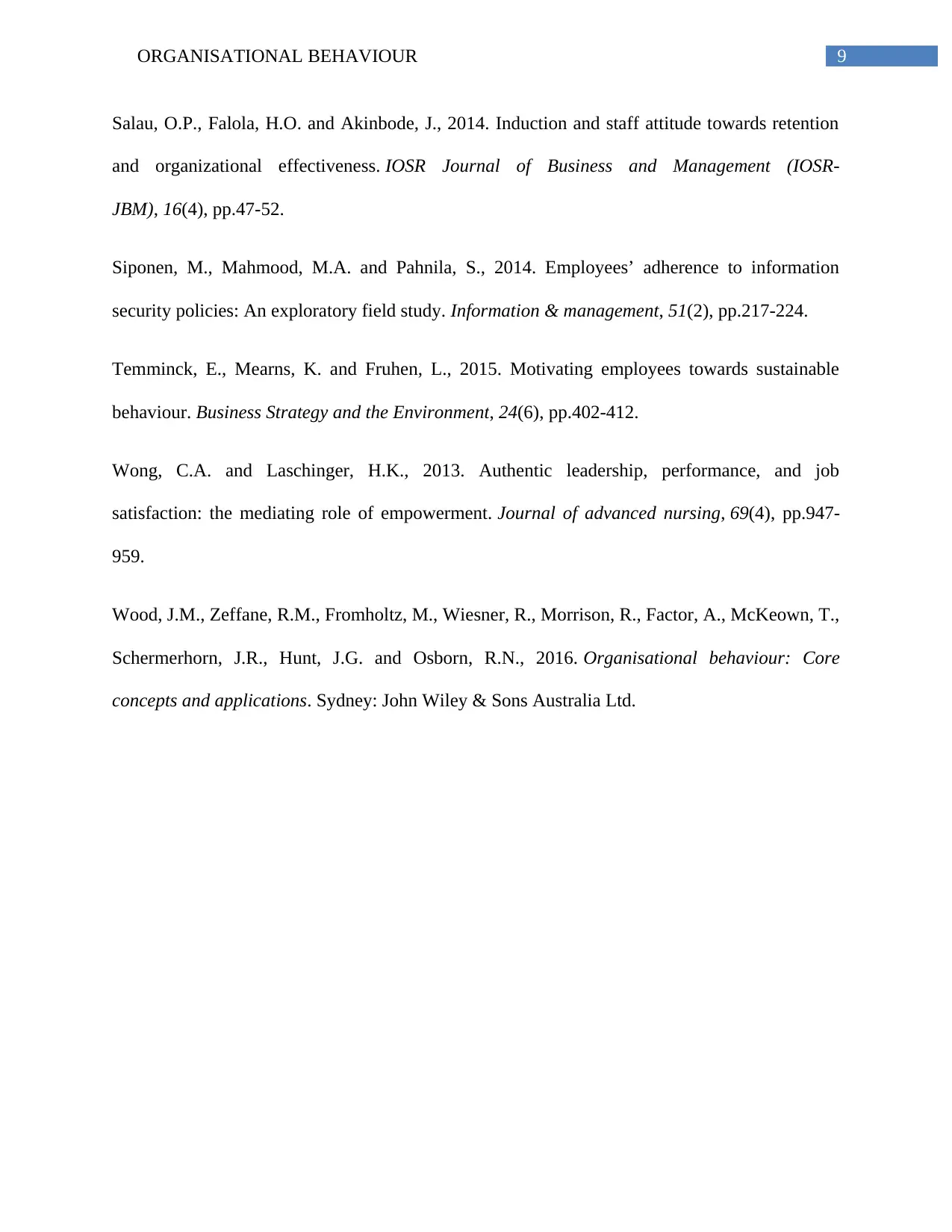
9ORGANISATIONAL BEHAVIOUR
Salau, O.P., Falola, H.O. and Akinbode, J., 2014. Induction and staff attitude towards retention
and organizational effectiveness. IOSR Journal of Business and Management (IOSR-
JBM), 16(4), pp.47-52.
Siponen, M., Mahmood, M.A. and Pahnila, S., 2014. Employees’ adherence to information
security policies: An exploratory field study. Information & management, 51(2), pp.217-224.
Temminck, E., Mearns, K. and Fruhen, L., 2015. Motivating employees towards sustainable
behaviour. Business Strategy and the Environment, 24(6), pp.402-412.
Wong, C.A. and Laschinger, H.K., 2013. Authentic leadership, performance, and job
satisfaction: the mediating role of empowerment. Journal of advanced nursing, 69(4), pp.947-
959.
Wood, J.M., Zeffane, R.M., Fromholtz, M., Wiesner, R., Morrison, R., Factor, A., McKeown, T.,
Schermerhorn, J.R., Hunt, J.G. and Osborn, R.N., 2016. Organisational behaviour: Core
concepts and applications. Sydney: John Wiley & Sons Australia Ltd.
Salau, O.P., Falola, H.O. and Akinbode, J., 2014. Induction and staff attitude towards retention
and organizational effectiveness. IOSR Journal of Business and Management (IOSR-
JBM), 16(4), pp.47-52.
Siponen, M., Mahmood, M.A. and Pahnila, S., 2014. Employees’ adherence to information
security policies: An exploratory field study. Information & management, 51(2), pp.217-224.
Temminck, E., Mearns, K. and Fruhen, L., 2015. Motivating employees towards sustainable
behaviour. Business Strategy and the Environment, 24(6), pp.402-412.
Wong, C.A. and Laschinger, H.K., 2013. Authentic leadership, performance, and job
satisfaction: the mediating role of empowerment. Journal of advanced nursing, 69(4), pp.947-
959.
Wood, J.M., Zeffane, R.M., Fromholtz, M., Wiesner, R., Morrison, R., Factor, A., McKeown, T.,
Schermerhorn, J.R., Hunt, J.G. and Osborn, R.N., 2016. Organisational behaviour: Core
concepts and applications. Sydney: John Wiley & Sons Australia Ltd.
1 out of 10
Related Documents
Your All-in-One AI-Powered Toolkit for Academic Success.
+13062052269
info@desklib.com
Available 24*7 on WhatsApp / Email
![[object Object]](/_next/static/media/star-bottom.7253800d.svg)
Unlock your academic potential
Copyright © 2020–2025 A2Z Services. All Rights Reserved. Developed and managed by ZUCOL.





